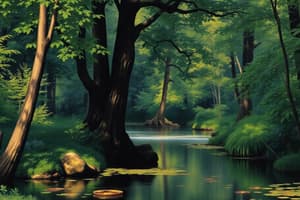Podcast
Questions and Answers
What was the concept of ecosystems introduced by Sir Arthur Tansley in?
What was the concept of ecosystems introduced by Sir Arthur Tansley in?
- 1935 (correct)
- 1940
- 1920
- 1955
Which of the following is NOT a consumer in ecosystems?
Which of the following is NOT a consumer in ecosystems?
- Decomposers
- Top carnivores
- Herbivores
- Producers (correct)
What do parasites, scavengers, and decomposers have in common in ecosystems?
What do parasites, scavengers, and decomposers have in common in ecosystems?
- They consume dead organic matter (correct)
- They are all producers
- They are all primary consumers
- They are all top carnivores
Which of the following is NOT an abiotic component of ecosystems?
Which of the following is NOT an abiotic component of ecosystems?
How do living organisms in ecosystems primarily adapt to environmental conditions for survival?
How do living organisms in ecosystems primarily adapt to environmental conditions for survival?
What role does water play in ecosystems?
What role does water play in ecosystems?
Which of the following factors influences the distribution of organisms in ecosystems?
Which of the following factors influences the distribution of organisms in ecosystems?
Why are ecosystems dependent on the balance between biotic and abiotic components?
Why are ecosystems dependent on the balance between biotic and abiotic components?
What is the primary role of green plants in ecosystems?
What is the primary role of green plants in ecosystems?
Flashcards are hidden until you start studying
Study Notes
- Ecosystems consist of both organisms (biotic components) and the environment (abiotic components) interacting with each other.
- The concept of ecosystems was introduced by Sir Arthur Tansley in 1935.
- Ecosystems can be natural (terrestrial and aquatic) or man-made (anthropogenic).
- In ecosystems, organisms are interconnected through energy flow, with green plants being the primary producers through photosynthesis.
- Consumers in ecosystems include herbivores (primary consumers), carnivores (secondary consumers), and top carnivores (tertiary consumers).
- Parasites, scavengers, and decomposers (saprotrophs) are also part of the ecosystem's consumer chain.
- Abiotic components of ecosystems include climatic factors (temperature, humidity, rainfall), edaphic factors (soil), and other factors like water balance, light duration, air quality, pH levels, and topography.
- Living organisms in ecosystems adapt to environmental conditions for survival, such as through physiological and behavioral adaptations for temperature extremes.
- Water plays a vital role in ecosystems, supporting life through its unique chemical properties and cycling through the biosphere via the hydrological cycle.
- The distribution of organisms in ecosystems is influenced by factors like soil salinity, topography, background color for camouflage, wind, water currents, and light duration.
- Ecosystems are dependent on the balance between biotic and abiotic components for their sustainability and function.
Studying That Suits You
Use AI to generate personalized quizzes and flashcards to suit your learning preferences.




